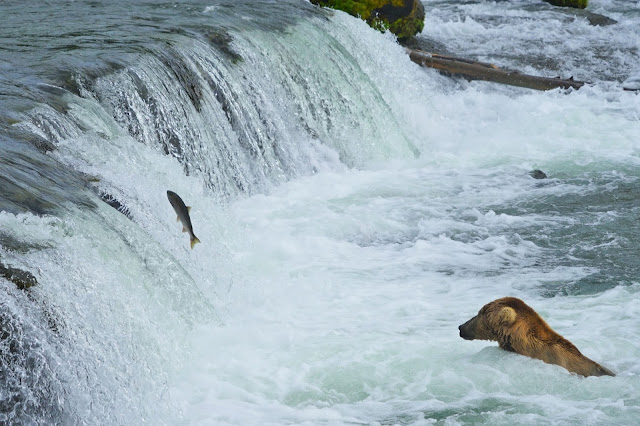 |
| Thick clouds all the way from Anchorage to King Salmon, but at least the plane took off. |
 |
| King Salmon to Katmai: a view from the float plane. The dark area on the left of the image is the smear of the propeller. |
After a 20 minute safety orientation at the National Park Ranger Station, we immediately walk down the path leading to the viewing platform. We are on the lookout for bears on this mile long trail, partly for our own protection.
 |
| Brooks Camp: during orientation, I notice through the window a sow and four cubs casually walking by about 40 yards away. I only manage a quick out-of-focus shot, with the mother already obscured. |
 |
| Brooks Camp: it is still drizzling as we start walking toward the viewing platform. |
 |
| Brooks Camp: This one-mile trail to the viewing platform is frequented by bears, so we keep the noise up not to surprise them. |
 |
| This bear is only several yards away but we are already ascending the protected walkway leading to the platform. |
Once we get to the platform, where an effective rotating system is in place, wow, it's everything I expected. It is a nature theater which showcases the interplay among the bear, the fish and the water.
 |
| There they are - bears in water. The platform is right in front of Brooks Falls where the main action is. |
 |
| Bear vs Salmon. It takes a while before we witness this bear catch a salmon. |
 |
| It finally catches one. |
 |
| Expertly removing the skin first... |
 |
| I am calling this a salmon burrito stage. |
 |
| Gulls are fighting for scraps. |
 |
| Further down the river, not the choice location, is where young bears usually hang out. |
 |
| On the far end of the falls, a big adult bear catches a salmon easily, with a gull seemingly cheering on. |
 |
| It then walks up and goes into the woods. Repeating this numerous times, it may be a sow feeding its cubs but we barely know their behavior, |
 |
| In the meantime, the bear in front of us is on a roll, consuming about 10 salmon in 30 minutes. |
 |
| Now clutching its new catch tightly in its paw |
 |
| Another bear caught in the moment of catching |
 |
| A young bear manages to catch a salmon. |
 |
| And quickly disappears to the safety of the woods. |
After our one hour session at the main platform is over, we walk back to the lodge for lunch. The return flight to King Salmon is scheduled late enough we can squeeze in another viewing session and we happily walk back to the platform where there is now a half hour wait.
 |
| Only several yards away but in complete safety of the raised walkway. |
 |
| Another bear walks right underneath the walkway. |
 |
| Salmon galore in the stream. Even I should be able to fish here. |
 |
| Returning after lunch, we wait our turn to go up to the main platform. But even in the unrestricted lower platform, there is plenty of action. |
Out in the river the drama continues, and it will probably do so for the duration of the month, and every year. And the lucky tourists will go home as satiated as the bears at Brooks Falls during the salmon run.
 |
| We have had our lunch. Salmon are still jumping. Bears are still hunting. Life goes on at Brooks Falls. |
 |
| A salmon seems so close to the bear's mouth. This is reminiscent of the classic photo of a salmon heading right into the wide open mouth of a bear. |
 |
| Both of these bears, a different cast than this morning's, have caught a salmon. |
 |
| Forget the bears - I could just watch the salmon action forever. |
 |
| High jump, Somersault, Pirouette! |
 |
| Synchronized salmon jumping |
 |
| Salmonic Contortions |
 |
| A new dominant bear appears and roams freely before heading down to the choicest spot. |
 |
| After catching a salmon with ease, it uses the stone as a table or a cutting board. |
 |
| Lens envy: plenty of very long lenses around |
 |
| But who needs a long lens? The dominant bear has come so close it almost fills the frame. |
 |
| And then it quickly disappears from the photographers. |
 |
| In the meantime, some salmon seem to land above the falls, but who knows, they may get immediately swept down. An exercise in futility. |
 |
| A new bear. Forget the salmon. It's bear vs water. |
 |
| Sadly it's time to go. A parting shot of a young bear downstream |
 |
| Bear trails below and human walkways above |
 |
| Back at the camp, enthusiasts are still looking for bears down the river with their binoculars. And they are finding plenty. |
 |
| We get to ride a float plane again. |
 |
| Katmai National Park from the float plane: pristine forests where no humans probably set foot for a long time |
 |
| Time to say good bye to Katmai National Park |


















